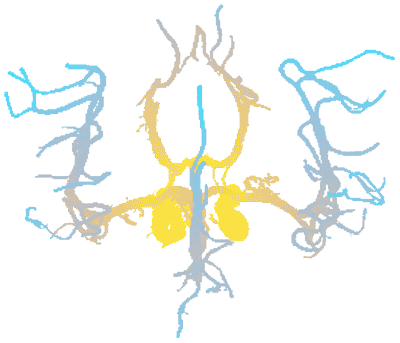In this section, we discuss three examples of patient-specific medicine where computational approaches are showing promise. Although the overall pathologies in each case are similar from patient to patient, the underlying details of the pathology can differ dramatically. In the case of HIV/AIDS and cancer treatments, the underlying mutations of these conditions are related to the genotype of the patient, and in the case of neurovascaular pathologies, the cerebral vascular structure differs considerably between individuals, so that each person will exhibit different blood flow dynamics. All these cases exemplify ‘patient-specific’ approaches, since the treatment is based on genotypic and/or phenotypic information obtained from the patient.
Cardiovascular disease is the cause of a large number of deaths in the developed world 7. Cerebral blood flow behaviour plays a crucial role in the understanding, diagnosis and treatment of this disease. The problems are often due to anomalous blood flow behaviour in the neighbourhood of bifurcations and aneurysms within the brain; however, the details are not very well understood.
Experimental studies are frequently impractical owing to the difficulty of measuring flow behaviour in humans; however, X-ray and magnetic resonance imaging angiography (MRA) enable non-invasive static and dynamical data acquisition 8. Indeed, some studies have revealed relationships between specific flow patterns around walls and cardiovascular diseases such as atherosclerosis 9.
Today, such imaging methods represent a very important tool for diagnosis of various cardiovascular diseases, together with the design of cardiovascular reconstructions and devices for the enhancement of blood flow. Notwithstanding these advances in measurement methods, modelling and simulation undoubtedly have a crucial role to play in haemodynamics. Simulation, for example, furnishes the clinician with the possibility of performing non-invasive virtual experiments to plan and study the effects of certain courses of (surgical) treatment with no danger to the patient, offering support for diagnosis, therapy and planning of vascular treatment 10. Modelling and simulation also offer the prospect of providing clinicians with virtual patient-specific analysis and treatments.
Reaching the goal of blood flow modelling and simulation is dependent on the availability of computational models of sufficient complexity and power. Furthermore, the neurovascular system varies between every single person, and so any computational approach will require patient-specific data. The aforementioned imaging techniques are used to provide data for such simulations. Furthermore, the computational fluid ‘solver’ used must itself be numerically highly efficient and provide scientists and neurosurgeons with the ability to manipulate and visualise the associated large data sets. The intricate geometry of the fluid vessels and treatment of fluid boundary conditions at such walls are also very difficult for traditional continuum fluid dynamics models to handle. Instead, a lattice-Boltzmann (LB) method, coined HemeLB, offers an attractive alternative. A major feature of HemeLB is real-time rendering and computation; fluid flow data is rendered in-situ on the same processors as the LB code, and sent, in real-time, to a lightweight client on a clinical workstation (Figure 1). The client is also used to steer the computation in real time, allowing the adjustment of physical parameters of the neurovascular system, along with visualisation-specific parameters associated with volume rendering, isosurface rendering, and streamline visualisation.







